What Midwinter, Spring-like Weather Will Do
/0 Comments/in Gardening, Pests, Vegetables/by Lee ReichMy Garden’s A Mess!
After some really frigid weather a month ago followed by more or less seasonal cold, temperatures did a loop de loop and we’ve had a couple of days in the high ‘60s. Very unseasonal, to say the least, and perhaps another indication of global warming, but welcome nonetheless. Those temperatures, coupled with brightening sunshine, made me want to get my hands in some dirt.
A large, second-story bedroom window overlooks my main vegetable garden. The weather made me see it in a different perspective — it looked messy.
I pride myself on putting everything in order each fall so that (quoting from Charles Dudley Warner’s 1886 My summer in the Garden) “The closing scenes are not necessarily funereal . . . A garden should be got ready for winter . . . neat and trim. . . in complete order so that its last days shall not present a scene of melancholy ruin and decay.”
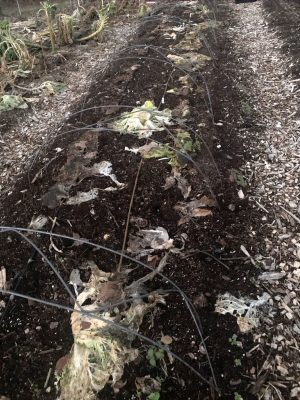
Not a pretty picture
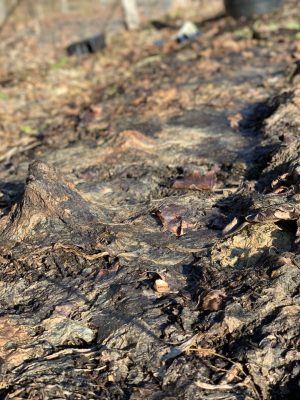
Endive, dead in January
Although I had mostly cleaned up spent vegetables and dressed the beds with an inch-deep layer of compost, early wintry weather put an end to that. Now, what I saw outside was too much “melancholy ruin and decay” from a few beds of late cabbages and their kin and tunneled beds of endive. The wilted, dried, browned leaves of unharvested endive lay flat, covering those beds.
Spring-like temperatures offered me the opportunity to get my hands in the dirt. I grabbed my hori-hori knife and gathered up frozen or dessicated leaves and plants for carting over to the compost pile. What a shock to even find some signs of life still out there in the beds: some arugula, some kale plants, and a couple of plants of baby pak choy and michili Chinese cabbage.
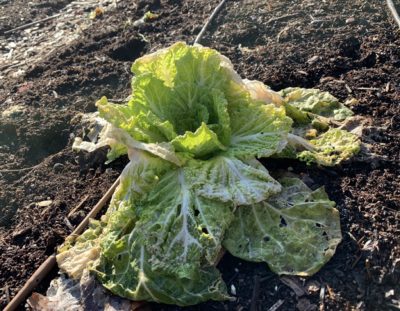
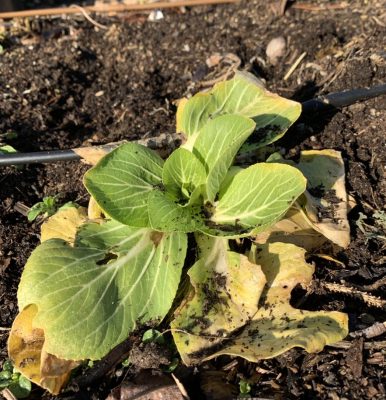
Coldest temperatures (minus 20 degrees F. here) typically arrive in late January. Those temperatures will do in these plants. Except for mâche, of course, which was also still alive in the garden, spry and green as if temperatures had never already dropped near zero, and which always survives winter.
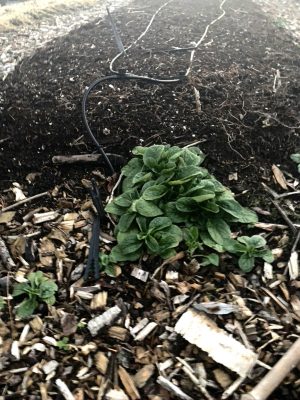
Mache, in garden in January
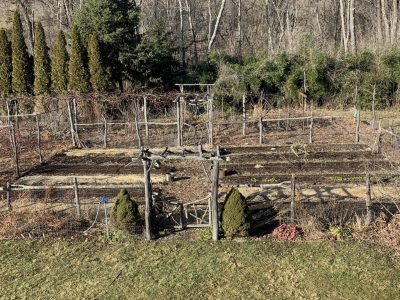
Garden after cleanup
First Seeds
That spring-like weather also gave me the urge to sow some seeds. These would be the first of the year, a seed flat of lettuce and baby pak choy to mature in early spring in the greenhouse. For some irrational reason, I’m never that confident that those tiny specks are actually going to sprout, even though I’ve done this successfully for decades.
Perhaps my lack of faith comes from my first experiences sowing seeds. That was many years ago when, as a graduate student, I lived in a motel room that had been converted into an apartment and began my first garden as an adult. I sowed all sorts of vegetable and herb seeds in peat pots that I set in trays on a shelf on a wall near a window.
All those seedlings died — and that was my abrupt introduction to “damping off,” a disease that attacks seeds and newly emerged seedlings. Imagine the disappointment of a beginning gardener (me) watching seedling stems pinch in at he soil line and topple over — the telltale symptom of damping off disease.
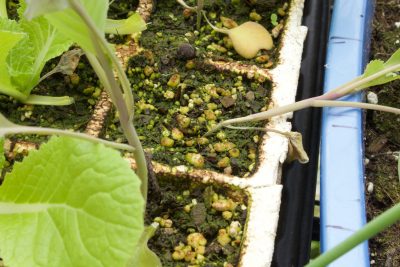
First Disease
I soon learned that damping off was not uncommon, even among experienced gardeners. The disease is caused by any one of a few soil dwelling fungi that raise their ugly head (figuratively) given the right conditions (for them). One obvious way to try to avoid the problem is to sterilize the potting media.
Most commercial potting mixes are sterile, as were the peat pots I was using. The problem is that the culpable microbes are everywhere, waiting to attack when conditions are just right, conditions that I unknowingly provided in my motel room. The peat pots were excessively moist; the air stood still; and little light entered the room — perfect for damping off development.
Nowadays, my seedlings rarely experience damping off. The plants get off to a good start at temperatures they enjoy, bathe in light in my greenhouse or sunny windows (or, in the past, cozied up very close to fluorescent bulbs), and a fan keeps the air moving. I also add sufficient perlite to my potting mixes so that excess water drains feely down and out of the mix. A thin layer of well-draining material, such as sand or calcined montmorillonite clay (kitty litter) can also help.
Years ago, soothing brews of chamomile tea would also come to the rescue — for the seedlings, not for me. That tea hasn’t been needed for a long time. I also don’t pasteurize or sterilize my potting mixes. Beneficial microbes, from the compost in my mix, and good growing conditions have thankfully made damping off nothing more than a distant memory for me.
Catalog and Weather Watchin’
/15 Comments/in Flowers, Planning, Vegetables/by Lee ReichArmchair Gardening
Pretty much the only “gardening” I’m doing now is thumbing through the seed catalogs arriving in dribs and drabs in my mailbox. I’ve ordered and received what I thought I’ll need, but you never know; maybe there something else interesting out there to grow.
Among the most fun of these catalogs, and strictly for the plant-crazed, is “The 2020 Ethnobotanical Catalog of Seeds,” which used to be called Hudson’s Seed Catalog. The catalog originates in the Santa Cruz mountains of California (once home to Ken Kesey) but offers seed from all corners of the world. Only recently have they come online, at www.jlhudsonseeds.net.
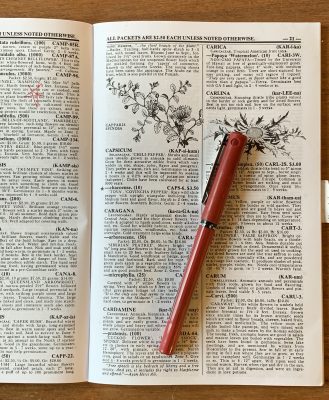
I’ve ordered from this catalog for decades, each winter pleasurably and slowly wading through the almost 100 black-and-white pages of small print listings of botanical names and descriptions. For this first run through the catalog, I sit poised with red pen, ready to make a star next to any seed listing that looks particularly interesting. After I go through the whole catalog once, I’ll re-examine all those starred listings and select which seeds to actually order and grow.
Judging from what I’ve so far starred, I seem this year to be drawn to scented plants. Achlys triphylla, also known as vanilla-leaf or sweet-leaf, is one such plant: “Dense spikes of tiny flowers held above the trifoliate fan-shaped leaves. Moist woods from B.C. to California. The sweetly fragrant leaves were highly valued by settlers, who hung bunches in their houses. Sow 1/4″ deep in rich woodland soil, and keep moist. Slow to germinate.”
Another is Adenophora lilifolia, also known as ladybells. This one is described as “sweet-scented light blue 1/2″ wide bell-shaped nodding flowers borne profusely in summer. Very hardy perennial to 1-1/2 to 3 feet, with round, heart-shaped basal leaves. Eurasia. Cultivated in Japan for the thick, edible roots. Germinates in 2 weeks.” For only $2.50 a seed packet, oodles of each of these plants can be growing in and perfuming my backyard this summer.
It’s not just visions of fragrant, comely, or tasty plants that make this catalog fun to read. Berkheya purpurea is native to Africa, with a common name Zulu warrior. How many plants conjure up an image like that!? The plant seems to me less warrior-like, with flowers that are large, silvery-blue to lavender daisies with dark centers. Interesting, but I don’t need another daisy for now.
Short quotes interspersed throughout the catalog set the tone and are food for further thought. Here’s one from Thomas Jefferson: “It does me no injury for my neighbor to say there are 20 gods or no God. It neither picks my pocket nor breaks my leg.” Or, going back 17 centuries, to Aesop: “Any excuse will serve a tyrant.” And then forward, to General Douglas MacArthur: “ If you win, you stand only to lose. War contains the germs of double suicide.” Or, to another American general, Dwight Eisenhower: “Things are more like they are today than they have ever been before.”
So far, I’ve only gotten as far as “D” in the seed listings. There’s still time.
Where’s Winter?
Aren’t temperatures supposed to get colder and colder and colder until the end of this month, and then get warmer and warmer and warmer? That’s how temperatures generally trend in coastal regions, near large bodies of water, and in western Europe. Not so here in the Hudson Valley and over most of continental North America.
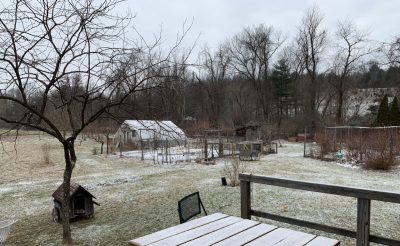
In my garden, the low was 3 degrees in early December and the high was 59 degrees a couple of weeks ago. Such fluctuations are not that uncommon over much of continental U.S. If you don’t like winter, you welcome those balmy winter days; if you like winter and/or like plants, those balmy days make you shudder.
Plants that can take our cold weather like the weather to stay cold all winter. Each time temperatures warm, especially after we’ve had a spell of cool weather, these plants start to awaken slightly from their winter slumber. The closer to spring and the warmer the weather, the more they awaken. Problem is that the more awake a plant is, the more likely damage, even for a cold-hardy plant, from subsequent frigid weather.
All this makes a good case for growing native plants. They’re more used to our mercurial weather and know better than to let a winter warm spell entice them out of their slumber.
However, many cultivated plants are not native. I like to grow fruits, and any fits of warm weather in weeks to come are going to make me nervous about the apples, plums, hardy kiwis, and pears, all non-native and sometimes awakening early enough to be damaged by subsequent cold.
Blueberries, pawpaws, persimmons, raspberries, and mulberries should be fine. Let’s hope for steadily cold weather and plenty of snow for the rest of winter.
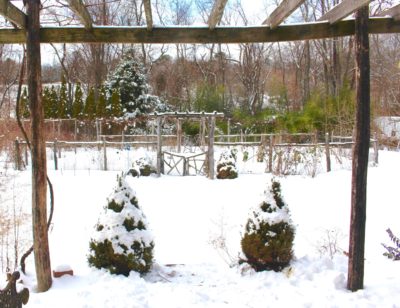
Older winter scene
SEED TIME
/14 Comments/in Flowers, Vegetables/by Lee ReichLate this Year
This year I’m late, but not too late, with my seed orders. Usually, I get them in by a couple of weeks ago.
The only seeds that I’ll soon be planting are those of lettuce, arugula, mustard, and dwarf pak choy. They’ll fill any bare spaces soon to be opening up where winter greens have been harvested. No rush, though, because I have seeds left over from last and previous years of these vegetables, and they keep well if stored under good conditions.
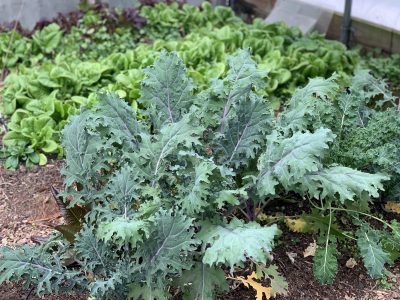
I’ve usually sowed onion seeds early also, in flats in the greenhouse in order to give plants enough time to become large transplants. Large transplants translates to large plants out in the garden before long days force them to shift from growing leaves to, instead, swelling their bulbs. More leaves before that shift makes for larger bulbs.
Last year, because of poor onion germination in the flats, I ended up getting fresh seeds and sowing them directly in the garden in early spring. Keeping the bed moist promoted quick germination and, by August, the bulbs stood up well, size-wise, to those from seeds sown in the greenhouse in past Februarys.
Seed Longevity
Onion and leek seeds don’t keep very well. Viable seeds are living, albeit dormant, embryonic plants which do not live forever. Conditions that slow biological and chemical reactions, such as low temperature, low humidity, and low oxygen, also slow the aging of seeds.
Seeds differ in how long they remain viable. Except under the very best storage conditions, it’s not worth the risk to sow onion, parsnip, or salsify seeds after they are more than a year old. Two years of sowings can be expected from seed packets of carrot and sweet corn; three years from peas and beans, peppers, radishes, and beets; and four or five years from cabbage, broccoli, Brussels sprouts, cucumbers, melons, and lettuce.
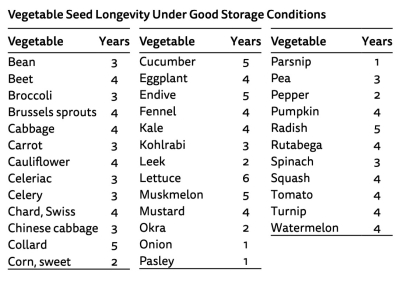
Among flower seeds, the shortest-lived are delphinium, aster, candytuft, and phlox. In general, though, most annual flower seeds are good for one to three years, and most perennial flower seeds for two to four years.
In a frugal mood, I might do a germination test for a definitive measure of whether an old seed packet is worth saving. Counting out 10 to 20 seeds from each packet to be tested, I spread them between two moist paper towels on a plate. Another plate inverted over the first plate seals in moisture and the whole setup then goes where the temperature is warm, around 75 degrees.
After one to two weeks, I peel apart the paper towels and count the number of seeds with little white root “tails”. If the percentage is low, the seed packet from which the seeds came gets tossed into the compost pile. (I don’t give them away!). Or, I might use the seeds and adjust their sowing rate accordingly.
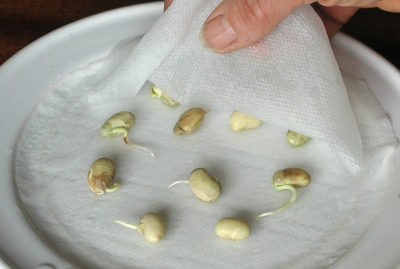
No one knows exactly what happens within a seed to make it lose its viability. Besides lack of germination, old seeds undergo a slight change of color, lose their luster, and show decreased resistance to fungal infections. There’s more leakage of substances from dead seeds than from young, fresh seeds, so perhaps aging influences the integrity of the cell membranes. Or, since old seeds are less metabolically active than young seeds, the old seeds leak metabolites that they cannot use.
Finally, Get My Orders In
Today I dug out my shoeboxes of seeds from the unheated workshop and noted what was missing and what was too old.
Needed still are yet undetermined, good varieties of Brussels sprouts, celeriac, semi-hot pepper, and melon. (Any suggestions for good varieties?) Also one or more packets of Bartolo cabbage, Blues Michili cabbage, Shintokiwa cucumber, Golden Bantam 8-row sweet corn, Blacktail Mountain watermelon, Carmen pepper, Mammoth sunflower, and Empress of India nasturtium.
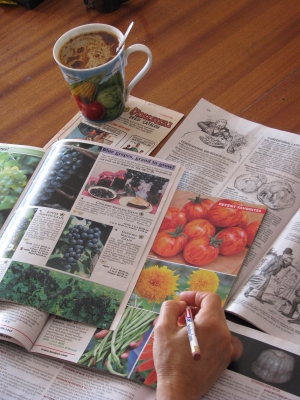
And, of course, some tomato varieties need replenishment: Sungold, Anna Russian, Nepal, Carmello, San Marzano, and Amish Paste. They will join Belgian Giant, Pink Brandywine, Paul Robeson, and Blue Beech out in the garden.
A colorful and flavorful growing season is in the offing.

